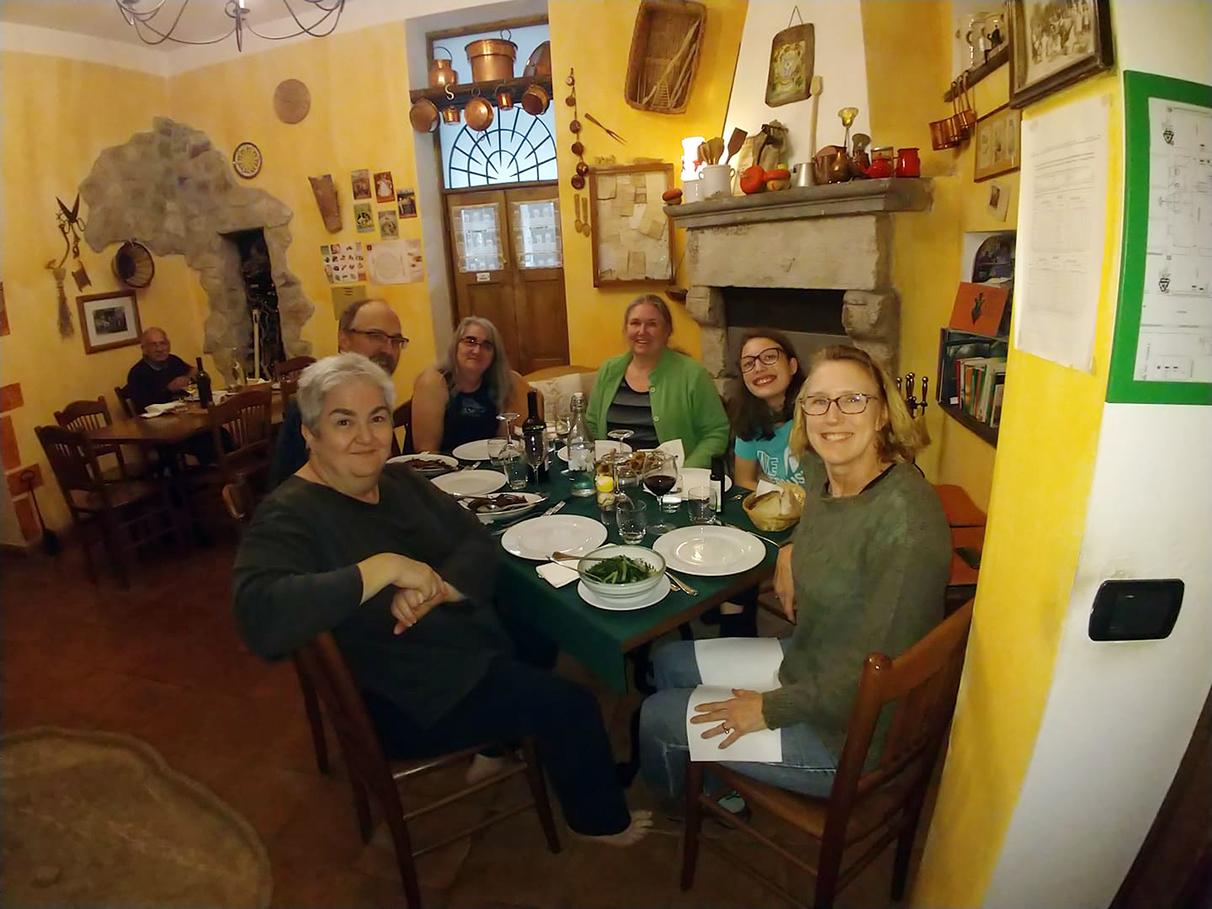]]>Article about Donatus Buongiorno published in academic journal
Day 16: Saturday, 3 November 2018.
Travel from Solofra, Avellino, Campania, to Caramanico Terme, Pescara, Abruzzo.
We got up early (for Carapelluccis), said goodbye to our wonderful hosts, snapped a few photos of them and their lovely property, also the view of Solofra from their hill (finally with no rain and decent light), then hit the road for our longest driving day, from one grandfather’s hometown to the other’s: Solofra, in Avellino, to Caramanico Terme, in Abruzzo—about 200 miles.

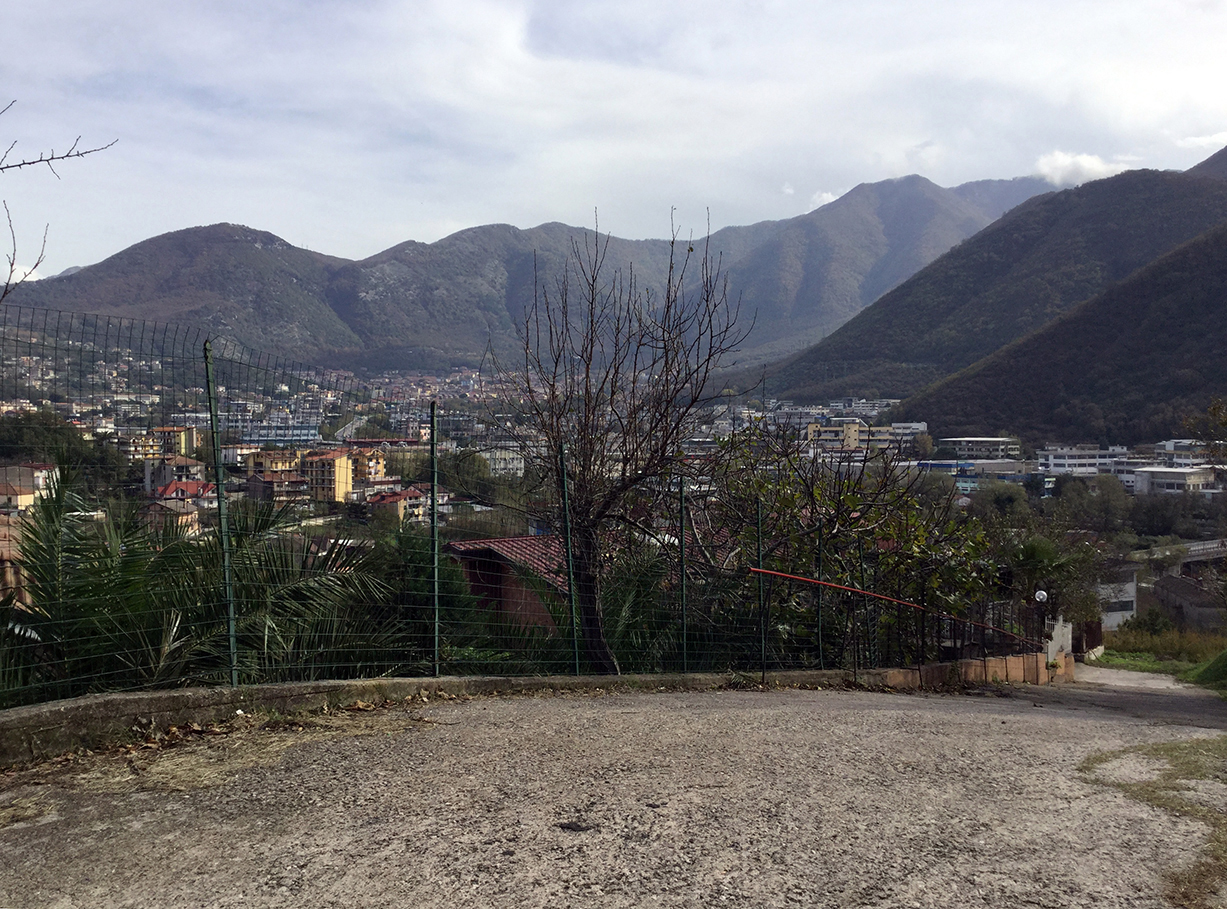
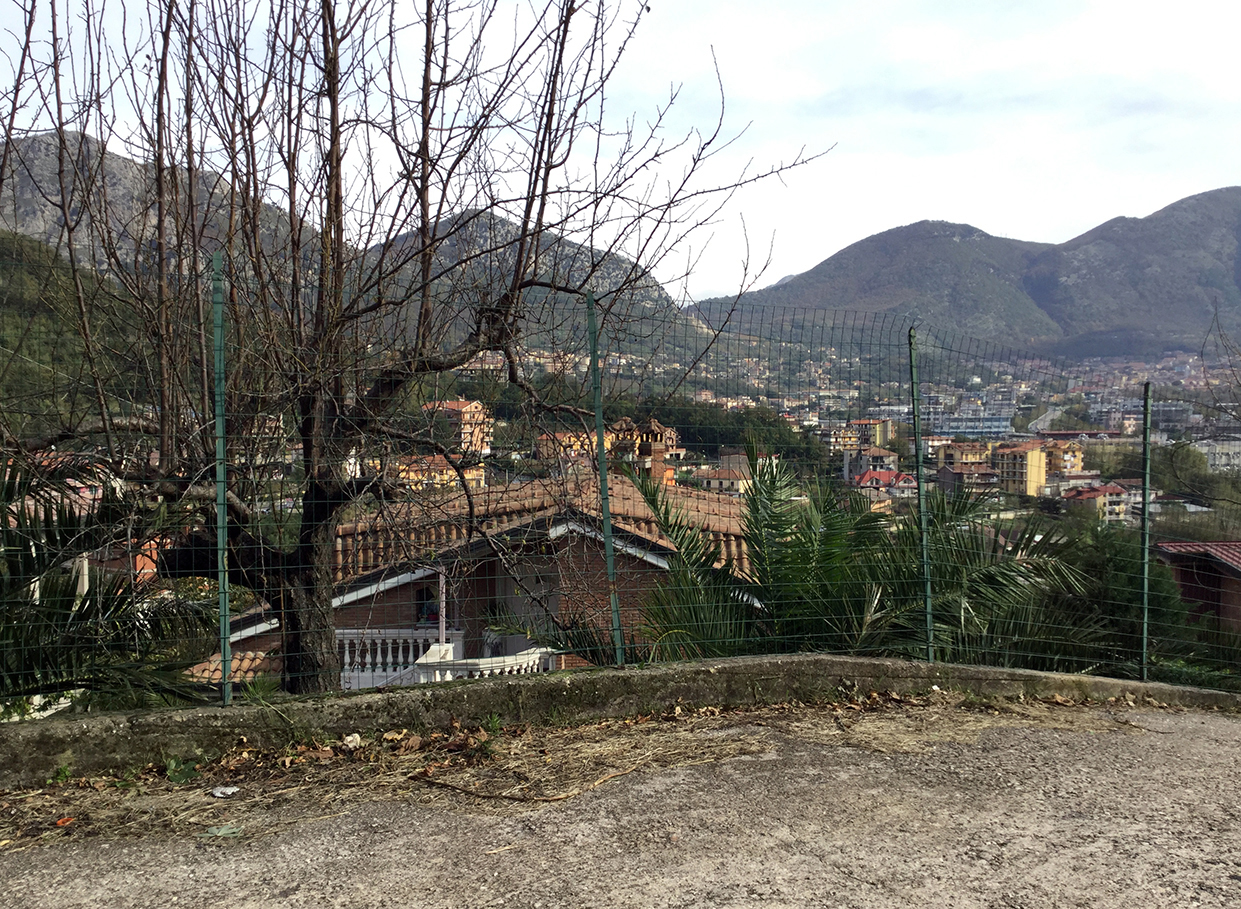
We had a nice day riding through the countryside of Campania, Benevento, a tiny bit of Molise, and Abruzzo.
Major shout-out of thanks to my fabulous brother-in-law Dave who did all the driving and my fabulous sister Loraine, who navigated using Google Earth on her phone. I got to sit in the back and just look out the window all day, like a princess with no responsibilities. (Princess Marg, for family members who know what that means.)
I made one contribution: a one-hour stop in the ancient ruins of the Roman city of Saepinum (Sepino), just outside Altilia. Read about it here.
A city on a former main road which Samnites, and later Romans, used to move their animals north and south seasonally, this place is totally off the beaten tourist path, and you can have it all to yourself. Park in the nearby restaurant and walk around, free admission.
It’s probably not a place worth searching out, unless you have a serious obsession with ancient cities. Not me! I’ve been spared at least one obsession, thank you, but if you ever find yourself on the north side of the mountains near Naples, do check it out for the rare experience of wandering a Roman site at will and not having other tourists mess up your photos.
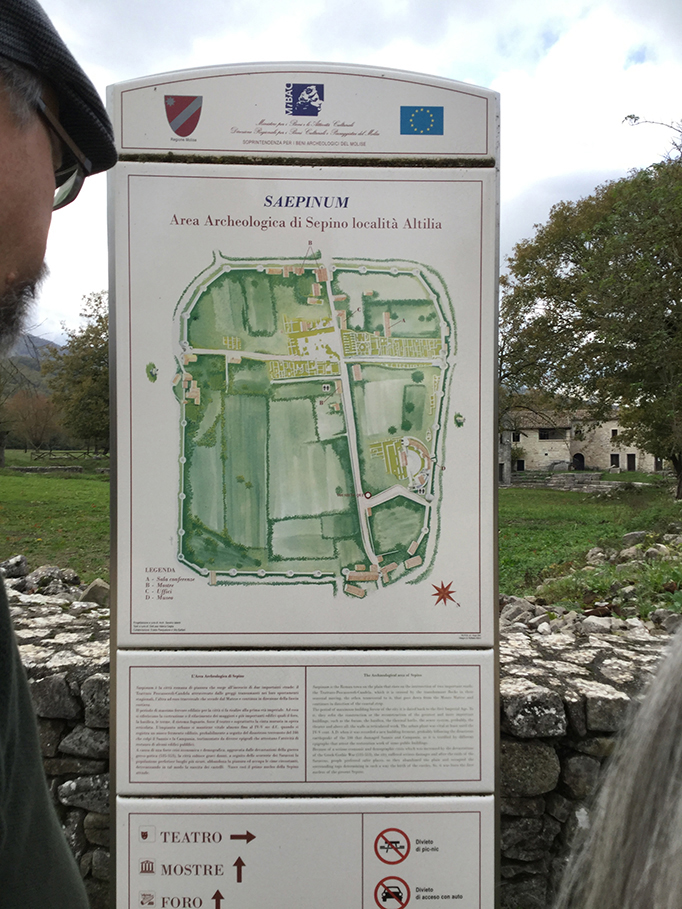

Click here to watch a contemporary performer on this ancient stage: Saep3
Being a graphic designer, I’m always a sucker for well-made Roman lettering. Pop quiz for anyone who’s been reading my posts from the beginning of the trip. What is the name of this font—it’s name now, having been known as “carved letters” at its inception, long before anyone knew anything about “fonts”?


Check out this “adaptive reuse” of a Roman plaque as the cornerstone of a medieval barn.
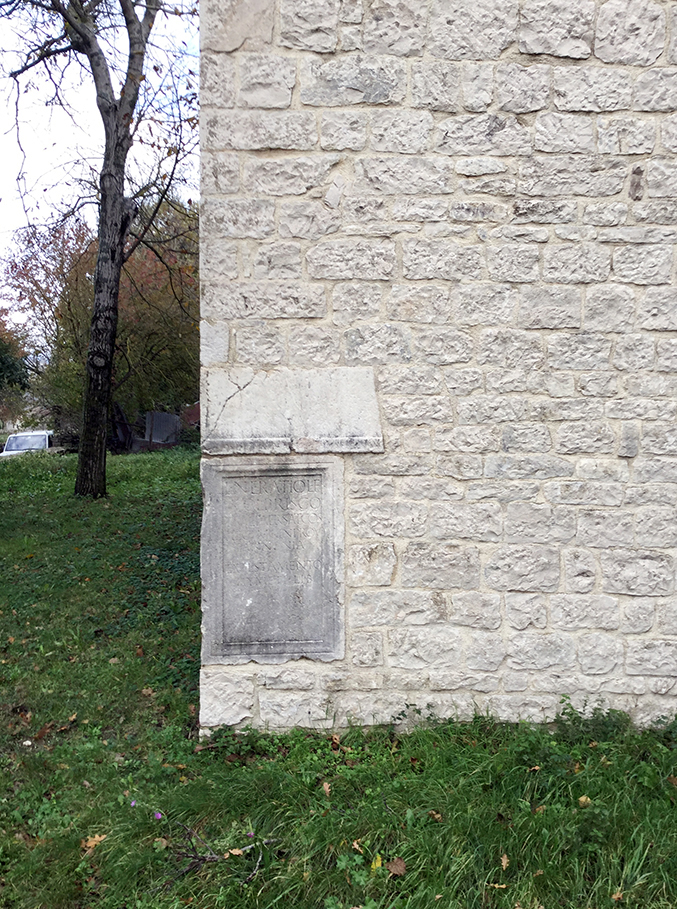

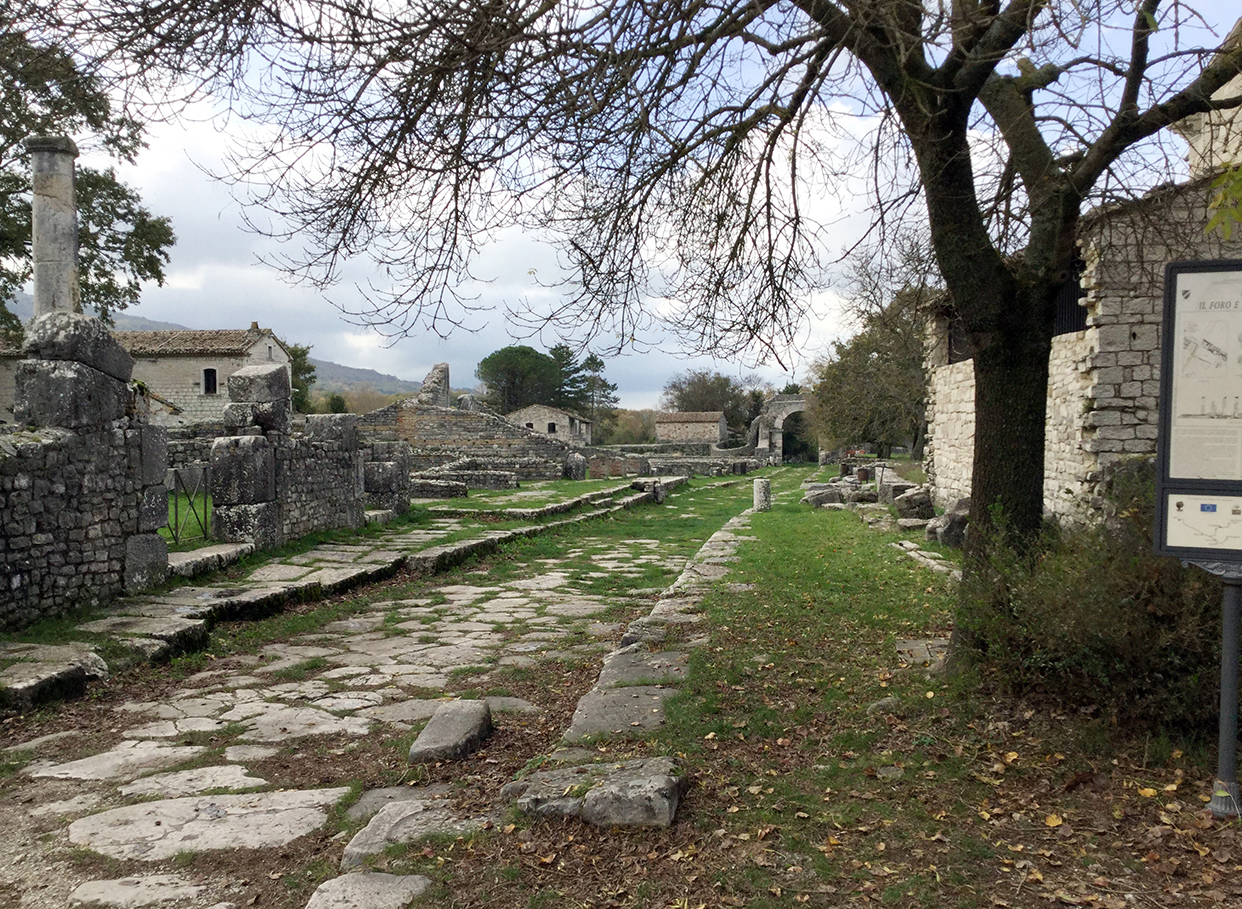
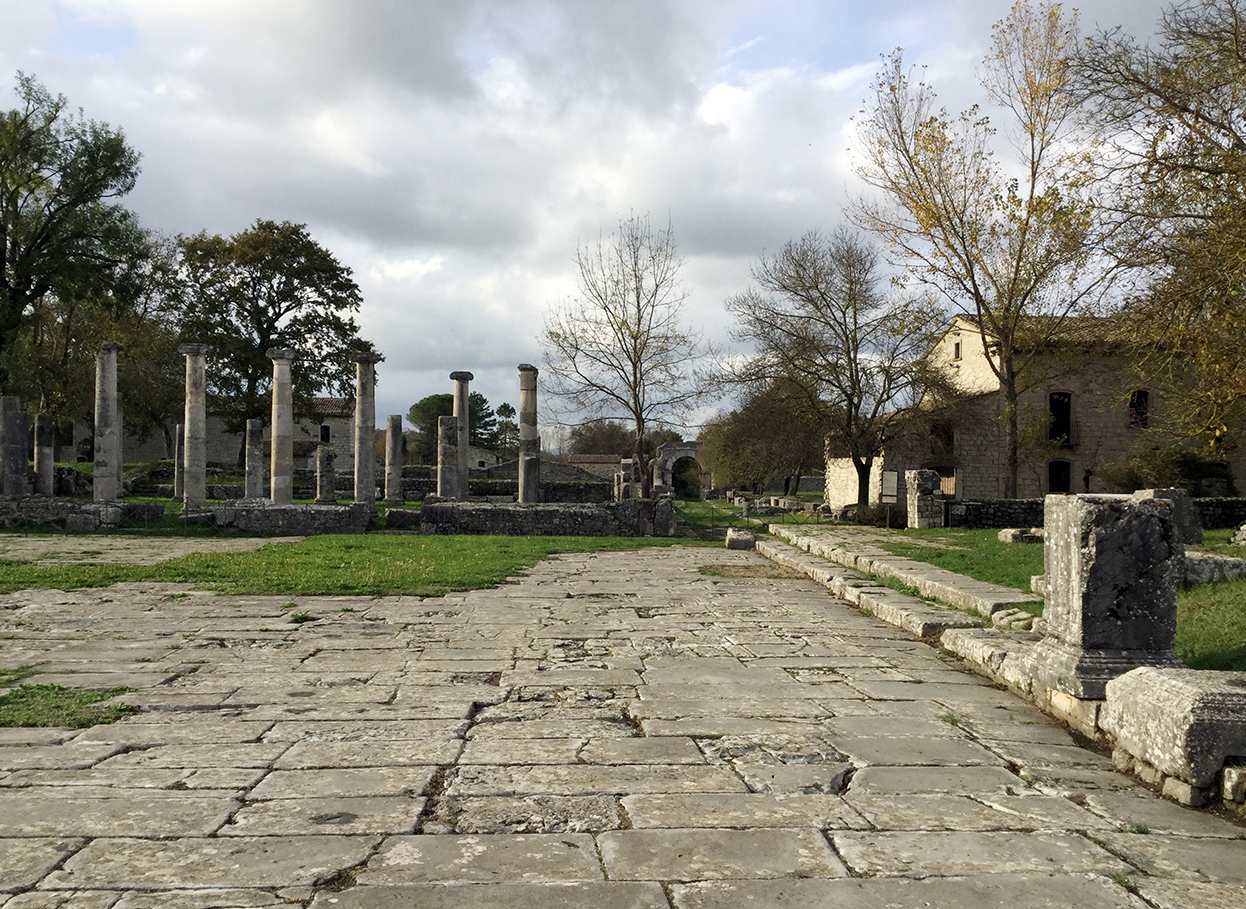
Back on the road, we see a lot of towns in the hills to both sides of the road. I expected back-county Italy to be poor and rundown. I’m pleased to report: not so. Though I only saw the towns from a moving car or at occasional rest stops on a highway, mind, I can report that there was farmed land everywhere (which was, presumably, thriving), every town had at least one or two factories (near the highway, plus maybe more elsewhere), and nowhere did the land or buildings look deserted, “untidy,” or rundown.
Plus, we saw multiple electric wind (mill) farms on the tops of ridges. At one point, we drove by a factory with parts out in the yard that I thought looked like airplane wings. Huh? Then it hit me: they were wind mill blades! So the mills were being made, and I guess assembled, mere miles from their sites!
I read later online that some people oppose the windmill installations for ruining their views of mountain ridges, but to us this is relative. In the U.S. we desecrate mountain tops with far more egregious strip-mining. I thought the windmills looked kind of cool.
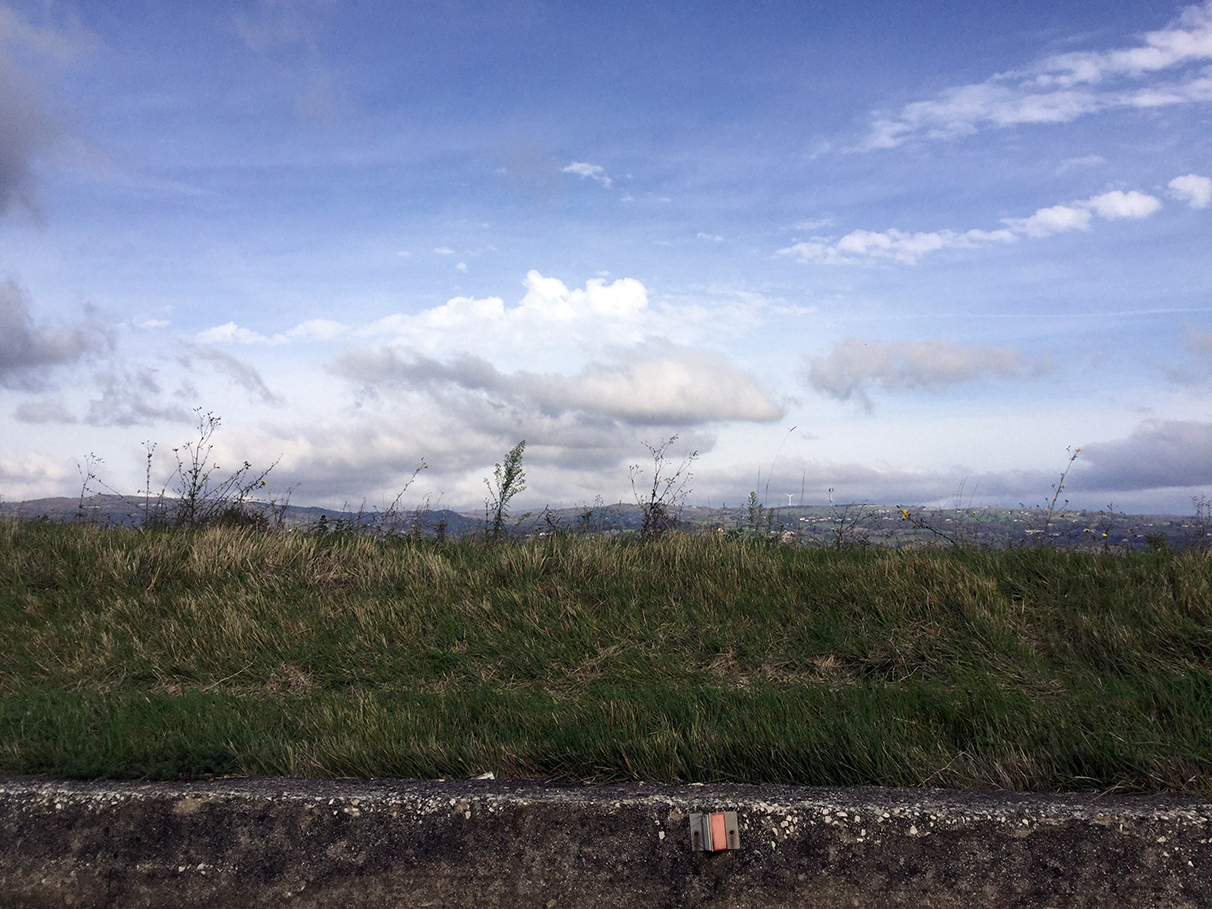
Also, the roads were well maintained, including in areas with serious winter weather, and there were numerous tunnels through mountains and bridges over high chasms.
Our drives were a lot faster than our ancestors’ trips in horse-drawn wagons when they left these towns in 1907, that’s for sure.
]]>
Day 15: Friday, 2 November 2018, morning.
Solofra, Avellino: All Souls’ Day, Giorno dei Morti (Day of the Dead)
Unexpectedly, we got another shot at meeting with Lucia Petrone, and my sister Loraine Carapellucci and I jumped on it. Without the translator this time, Loraine wielded Google Translate on her phone and Lucia used Google Translate on her computer. Between the two machines and my tiny bit of Italian vocabulary, somehow we communicated with each other.
First, Lucia showed us two books on the town’s history. Were they available to buy? No. No more in print, no extras in the office to sell.
So Loraine and I started photographing their pages, then Lucia interrupted us to tell us more information and to show us stuff on her computer. She would start to talk, then stop and type frantically on Google Translate instead. I loved the woman’s enthusiasm!
Loraine and I whipsawed between looking at Lucia’s computer, looking out the window at the church across the street, and photographing those unavailable books.
Lucia told us the story of the construction of the Collegiata di San Michele church, which astonished us.
The night before, we had learned from Alfonso Buongiorno how the tanning industry Solofra families started as conversos (former Jews) from Spain who migrated to Florence in the 1300s, which was the tanning center of Italy. At some point, they were invited by someone (a land baron) to move to Solofra to set up a competing industry.
Lucia explained that there had been an old church on the site of the Collegiata which the families deemed inadequate. In the early 1600s (which would be approximately 200 years after the converso families arrived in Solofra, so presumably the tanning business was profitable by then), they demolished the old church and built the Neapolitan Baroque building that exists today.
If we got the translating correct, Lucia told us the tanning families of the town pooled their money to build the church, and the chapels inside are named for them. They also hired the priest, who, besides directing spiritual life, functioned as the mayor (of sorts, this is before suffrage) and settled civil disputes. At one point, there was an argument over some matter and the priest defended the town instead of the government/crown. He was arrested, and the townspeople got him released.
“Collegiata”—collegiate—in the church’s name means it was also a school. There was a convent attached, and the nuns taught classes. Most astonishingly, girls attended as well as boys. Today, the school is, appropriately enough, the town’s public library.
And the church had one more role in town: bank. The founders of the church would deposit their money, and the church paid them interest. When they needed it, they could borrow it back, and then they would pay interest to the church.
This is an astonishing amount of power and autonomy centered in a non-governmental, non-royal institution. I’ve never heard of it anywhere in Italy, let alone in the south where the feudal system endured into the late 1800s. Has anyone else? Did we get the translating wrong?
When I told the story above to my friend Bill Russo in New York, I expressed it as, “They hired the priest, and he worked for them, not for the Vatican.” Bill blurted out, “That’s how a synagogue is organized!”
Is Solofra’s extraordinary history of progressiveness, self-reliance and agency a cultural legacy of its original families’ Jewish roots? Did the historic, formerly Jewish culture of this town create my ancestors’ can-do, optimistic personalities?
Looking out the window, Loraine remarked, “But what about the campanile (bell tower)? It looks different from the church.”

Lucia paused and placed her hand over her heart looking very pleased. Her reply: The campanile was built with the stones from the old church.
Loraine pointed out to me later that that question seemed to change the tenor of the whole afternoon. A switch flipped in Lucia’s head (and heart) regarding us: they get it. They care, and they are becoming involved in our history.
A few minutes later, when we were photographing the books again, Lucia came to the table, closed both books and pushed them across the table to us. “A gift. Please take.” We were speechless.
I hope she decided that those books were going to do more good for Solofra being on our desks in the U.S. than in a cabinet in her office, because Loraine and I aim to prove her right! We traded emails and plans to collaborate on future projects.
At one point, Mimma De Maio phoned in, so I finally got to talk to her in person and thank her for all of her work which I have been reading for years. She was my first “door” into the history of this town.
I suspect I am going to be involved with my grandfather’s family’s Italian hometown of Solofra, Avellino, for the rest of my life. And I am well pleased.
]]>Day 14: Thursday, 1 November 2018, afternoon.
Solofra, Avellino: Visit to Casa Buongiorno.
As promised, Alfonso Buongiorno arrived at our Agriturismo (with his brother-in-law, whom he enlisted to drive a second car) on Wednesday afternoon to take us (party of 6) to his home on a hill above Solofra. Alfonso, his brother, and his father Francesco own one of the tanning businesses in town, and they have new homes near each other in a “compound” that they built on the side of a hill above the old part of town.
When I walked in and saw 19th-century paintings on the walls, I knew I had found a soul mate. Alfonso said, “They aren’t expensive. I buy what I like.” I smiled and made a mental note for a future project: get Alfonso interested in hunting for Donatus Buongiorno paintings that are in Italy.
We met his wife Maria Giaquinto, who is an Izzo from Montoro Superiore, a nearby town. Remember New Yorker Bill Russo whose parents were both from Montoro Superiore? Bill’s mother was Anna Izzo. I felt the spirits starting to circle.
Bill actually found Alfonso for me. On Facebook, of all things. Much as I hate that site, I’m grateful it worked for this, because meeting Alfonso Buongiorno was a highlight of my trip to Italy.
Next we met Alfonso and Maria’s two teenaged children, Raffaella and Francesco, who couldn’t hide that they were a little annoyed that company arrived just as they were planning to go out with friends, and they were now expected to linger and be nice. (The ritual for the holiday, apparently, is that adults go to the cemetery and youngsters go to parties.) I didn’t catch all of the words, but I think the gist of the whispered conversation was “Daaaaaad….,” followed by “Just stay for a few minutes and be polite.”
Next Alfonso guided us to his office in a corner of the living room and on the wall was this beautiful artwork of his family tree. Holy moly.
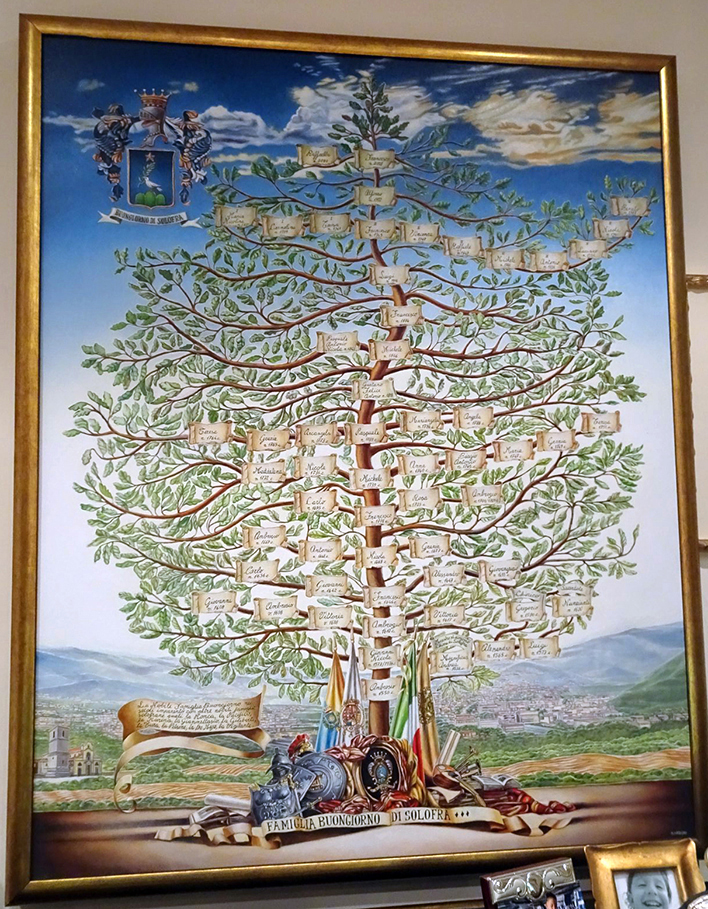
Then he pulled out a rolled up sheet with the family tree of “our” Buongiornos which I had emailed him before the trip (an org chart of boxes generated by a genealogy software program, with not-such-nice artwork). It was poster size. He ordered a digital printout somewhere.
(My work goes back to the 1850s and is based on vital records on microfilm I spent three years of Saturday afternoons reading at a Mormon Family History Center in Brooklyn. You’re welcome, Buongiornos and Troisis.)
Alfonso says, “I have figured out how we are connected. This Michele,” points to a leaf on his tree, “was a brother of this Biagio,” points to my chart, identifying two men who lived in the 1700s.
We are thrilled, and my cousins start snapping photos of all of us, of the “evidence,” etc. (Thank God they were there, because my brain was too overloaded to deal with a camera.)
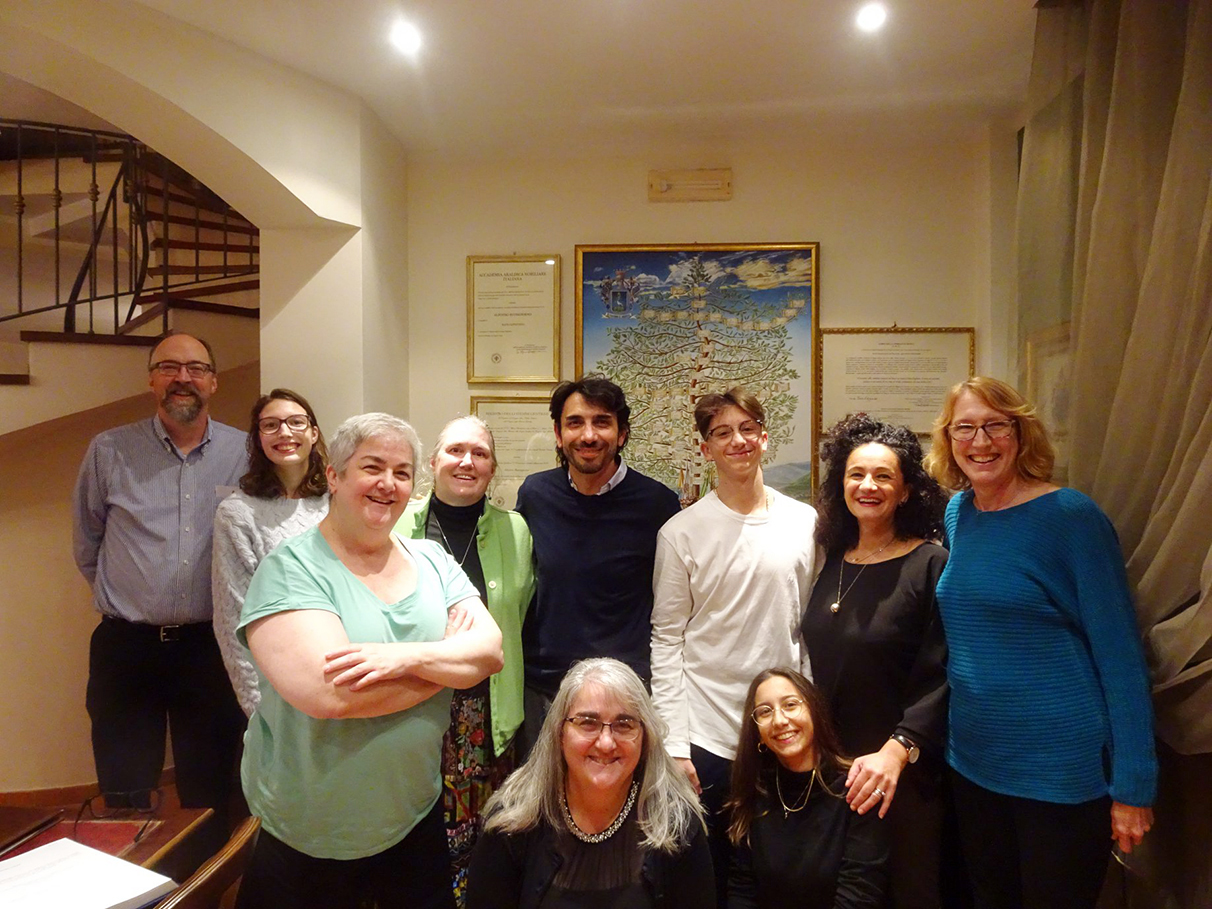
Then Alfonso pulled out the “report” that an Italian genealogist prepared for him of records going back to the 1300s: a 3-inch thick, bound book, on archival-quality paper, with pages that fold out and flip around, xeroxes of some documents, raised-seal (legally legitimate) copies of others.

My cousin Lisa said later, “I kind of blanked out there for a few seconds, because I can’t even conceive that anyone’s ancestry could be known back to the 1300s.”
Alfonso turned to a page he had marked in advance and said, “We are Jews. Conversos from Spain.”
He pointed to a line he had underlined. “The family name Buondiaz (Bonadies in Ladino) was translated to ‘Buongiorno’ in Italy.” (Spanish, Ladino and Italian, they all mean “good day”—which is used for “hello.”)
My family members’ jaws dropped; I smiled with pleasure. I had heard of this possibility before.
Years ago, an Italian art dealer told me that Buongiorno might be a Jewish name, explaining that “conversos”—Jews who converted to Catholicism in Spain during the Inquisition—were also forced to change their Jewish-sounding family names. They often “hid in plain sight” by choosing very common words from the local language for their new last names, such as “hello, goodbye, good day, good year.”
Alfonso explained that the family were tanners in Spain. When they left Spain in the 1300s, they went to the tanning center of Italy: Florence. After being there for a few hundred years, a Solofrano land owner (baron) offered them a deal—land for tanneries, plus favorable terms (probably in exchange for substantial taxes)—to move to this place in the south that had the necessary raw materials (goats, sheep, water) to set up a competing tanning industry.
They have been successful. Florence and Solofra together produce 60% of the leather that is used by the Italian fashion industry today.
Now I understand why Mimma De Maio—the Solofra historian who wrote solofrastorica.it—did her Ph.D. dissertation on the “medieval” tanning industry of Solofra. Because that’s when the industry started in this town; her paper is about the entire history of this defining industry of this southern town.
And now I really have to learn Italian, so I can read that paper, and more of her website.
Alfonso’s family are still tanners. He and his father and brother own a tannery in town.
At some point, “my” Buongiornos, the ones descended from 1700-something Michele’s brother Biagio, left tanning, and by the 1800s, were tailors, barbers, midwives and artists (which I know from my Mormon Family History Center research.) Why and how, I don’t know. As always with genealogy, answers to questions beget other questions.
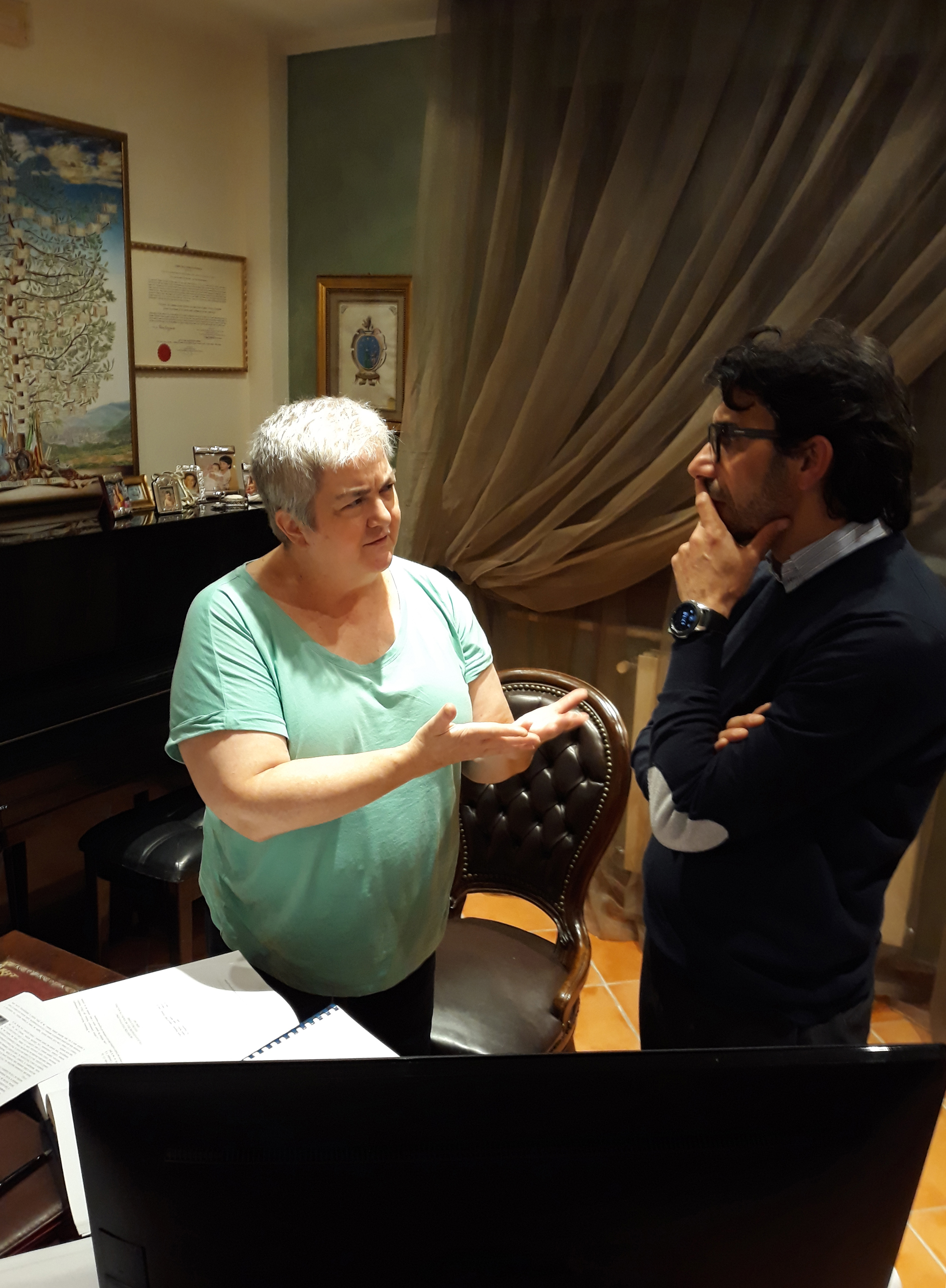
We are hours into our visit. Alfonso and I can go on about genealogy indefinitely, but our family members are ignoring us to eat snacks and talk about other subjects. Both teenagers are still in attendance, engaging with the American relatives they were sure would be bores.


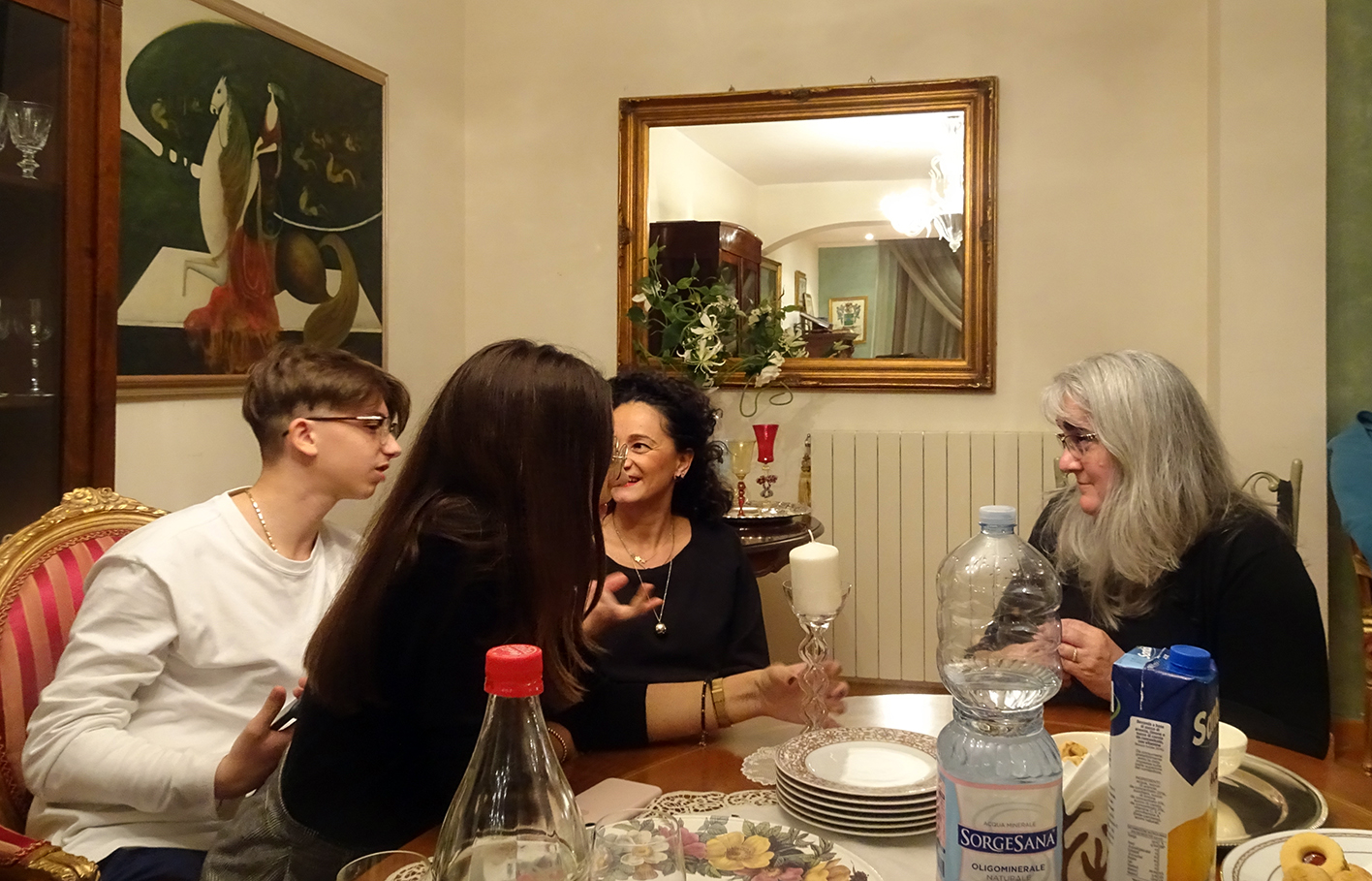
————————
I would like to pay back Alfonso for his hosting and overall wonderfulness by finding him leads for selling his leathers, and this is where you, dear readers, can help.
The tanning industry in Solofra took a serious hit with the 2008 worldwide economic downturn, and Chinese competition is edging in. Alfonso needs a customer who can not afford the time and interruption lost to bad deliveries or not receiving enough usable product to fill an order—someone who will pay a higher price to get reliable product on time. We are looking for a very high end fashion/luxury wholesale customer: a manufacturer who makes gloves, clothing, shoes, wallets, belts, etc.
Do any of my readers know of such a customer? I would not be involved other than to pass a name and phone number to Alfonso’s sales rep in New York. Please use my email or phone to contact me, both are visible all over my websites, and THANK YOU.
————————
Thanks to my sister, Loraine Carapellucci, my brother-in-law, Dave Handley, and my cousins, Julie Holm and Lisa Hamm-Greenawalt, who shot the photos in this post.
]]>Day 14: Thursday, 1 November 2018, morning.
Solofra, Avellino: Ognisanti—All Saint’s Day
We started the day with a breakfast visitor: distant cousin Alfonso Buongiorno. He told us a little history of his family as tanners in the town and asked, “Would we like to visit his home later in the afternoon to see his family tree and talk more?”

“Hell yes, we’ll be there,” I was thinking, but I held back and pretended to wait for my family members to discuss it and come to a group decision. Arrangements were made and he left.
Then we trooped into town to attend the holiday mass in our family’s church. Feminists all, we were favorably impressed that the pastor, Father Mario, made it as progressive as he possibly could within the “rules” of a Catholic mass. Women parishioners helped served communion, and young girls did a reading.
After mass, we followed the crowd to the nearby cemetery, as visiting the dead is what you do on All Soul’s Day. It was down a hill about a mile away.
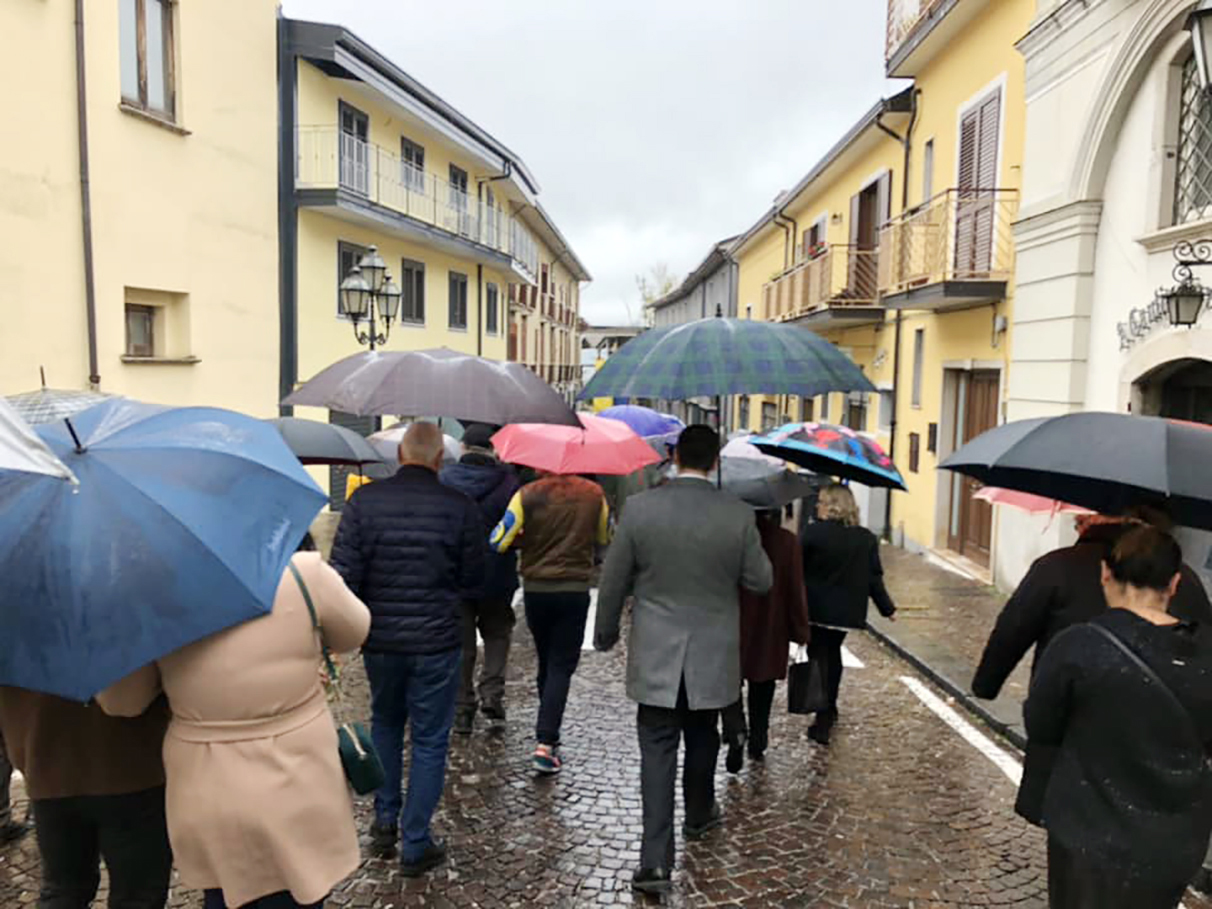
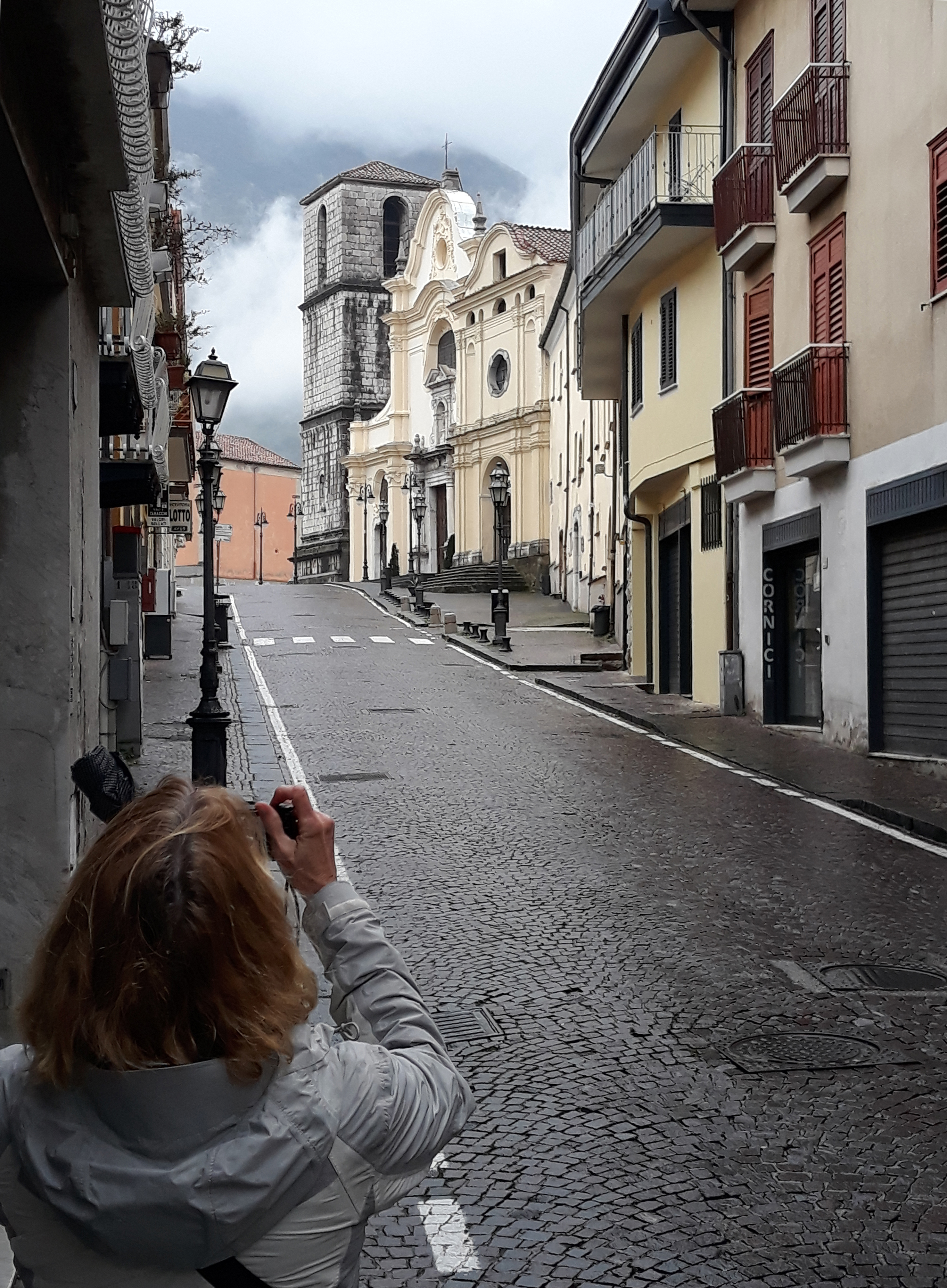
I walked with my sister Loraine for a while. She spied a broken-down chapel and asked if I wanted pictures of it. “Yes, thank you.” I didn’t tell her that it was one of the 5 or 10 “historic” buildings in town I had spied (and marked on a map) while “walking around” via Google Earth 10 years ago—checked that box. (By this point, I was keeping mum about some of my “planning lists,” as my family members were already worrying that I was a bit “around the bend” with my agenda for this trip.)

It was hard to imagine what Solofra looked like when our family lived there in the 1800s, because the 1980 Irpinia earthquake hit this town hard. Some buildings, like this chapel, were left as ruins, while others were rebuilt with new finishes (covered with a thick coat of cement-like material which ruins their historic appearance) or are completely new..
I’m a pokey walker and was lagging behind my family after 10 minutes or so, when…I got a ride! I spied an elderly man I had met the night before (in the church) in a car, waved like a maniac, knocked on the window, and he said, “Sure jump in and get a ride from my son-in-law” (the driver.) I pretended to chat and understand what the three of them were saying in Italian while cruising down the hill to where I met my family members who hadn’t even realized I was missing.
My sister Loraine got pulled out of the route by a local elderly woman who wanted to show Loraine her church, which was along the way. So Loraine went in and dutifully walked around for a few minutes.
Loraine and I found this happened routinely in both of our grandfathers’ small towns which we visited. People were interested in us and proud of their town and wanted to show us things. They also routinely didn’t care that we didn’t understand their non-stop Italian chatter.
The cemetery was interesting. There were lots of tombstones with photos on them and lots of mausoleums with family names on them, including names that we recognized, but we learned that none of them were going to be relevant to us: too new. We were told that graves (in most of Italy and much of Europe, apparently) are re-used after 50 or so years, that the bones that are dug up and put in common ossuaries without specific records of who is in them.
In all the years I’ve spent preparing for this trip, and in the flurry of emails during the last month before I left the U.S., someone couldn’t have told me this crucial detail?
Our ancestors left Solofra in the late 1800s and died in other places—Naples or the U.S. The graves of any family members before them who had been buried in Solofra had been recycled years ago, so we were not going to know anyone in this cemetery.
That kind of killed our interest, but I took a few photos of the more flamboyant tombs anyway, including this Egyptian style monument which can even be seen from the road outside the cemetery (Google Earth photo inserted because I can’t find my own shot), and this grave of a Russo that has a photo (of the dead guy), for my friend Bill Russo of New York, in case they are related, as his family is from Montoro Superiore, a town that is only a mile away from Solofra.
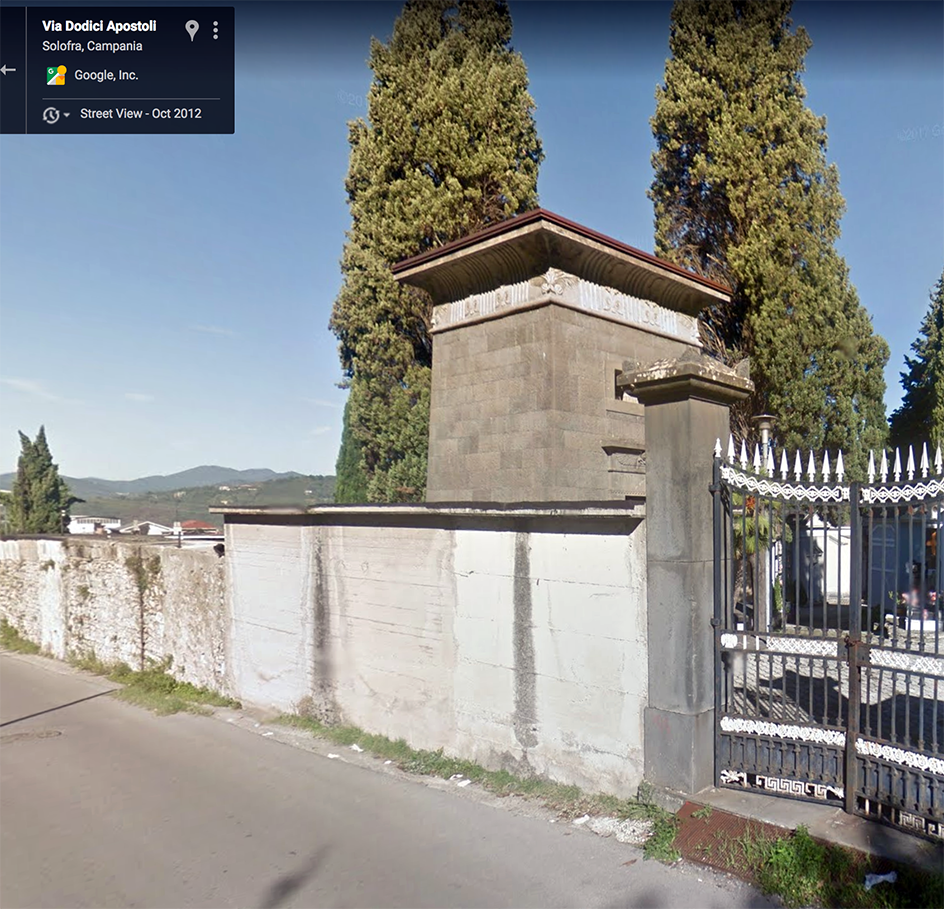
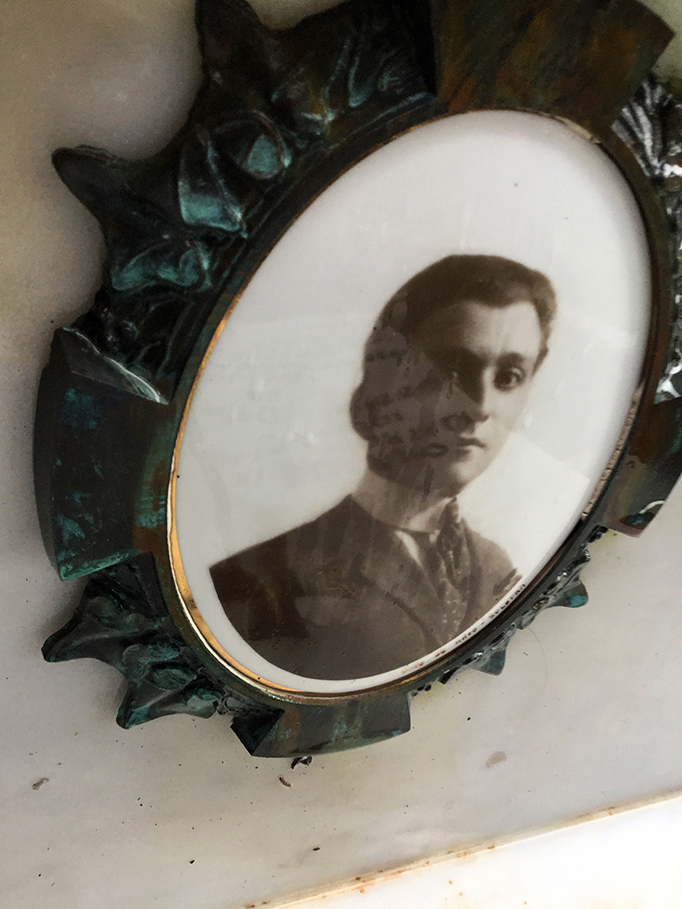

So the cemetery part of the “genealogy experience” of this trip was a bust. But it helped Loraine and I refine our plans for the second, small town we were going to visit. When we went to our other Italian grandfather’s home town the following week (in Abruzzo), we skipped its cemeteries.
We left the Solofra cemetery and went back up the hill for lunch in the main part of town. Then we went back to the Agriturismo to clean up (it had rained all day) for our visit to Alfonso Buongiorno’s house.
Thanks to my sister Loraine Carapellucci, and to cousins Julie Holm and Lisa Hamm-Greenawalt who shot many of the photos in this post.
]]>Day 13: Wednesday, 31 Ottobre 2018.
Travel from Napoli, Campania, to Solofra, Avellino.
Busy day.
We got up early, hustled to the train station, hustled to figure out how to buy the correct train tickets in a vending machine that was in Italian, figured out whose internationally registered credit card to use so it wouldn’t get rejected for being foreign (Julie’s), and hustled to get on the correct train. The one-hour ride to Salerno was pleasant and uneventful. It was a brand new train on brand new tracks.
We hiked through the Salerno station and crossed the street to a rental car place which was reasonably efficient (for Italians) at producing a car in under an hour. Then we wormed our way through local streets to get out of town and headed north on a highway. My sister Loraine was the navigator looking at Google maps or something on her phone and telling her husband Dave, the driver, directions, where to turn, how far to go until the next decision point, etc. It worked splendidly.
In Solofra, we went directly to the Collegiata church, figured out where to park, met our hired guide, Giuseppe Guanci, and got to the city hall by noon for our appointment with Lucia Petrone.
Big breath of relief.
Lucia is lovely and gracious—and speaks machine-gun-fire Italian. Giuseppe can hardly keep up, and when he’s translating to English for us, she interrupts him to tell him even more information in Italian. We hear about the city hall (former palace of Orsini family feudal land owners) and the Collegiata church (La Collegiata di San Michele Arcangelo), all of which I already knew.
It was the afternoon before a 4-day holiday weekend. Lucia had promised us two hours, and I think she was feeling the pressure, as much as we were, to pack those two hours with information.
Me: What about Donatus/Donato Buongiorno? He worked on a restoration of the Collegiata in 1908…?
Don’t know anything about that, but if you want to provide a (mural-size) copy of one of his paintings, we will frame it and hang it in our fancy meeting room here at city hall with the Guarini paintings (reproductions) we already have on display.
Not shabby company for Buongiorno, I think to myself, and make a mental note to follow up on this.
Lucia insists she must show us the church, so we go downstairs, cross the street, and go inside. In one of the big side chapels, Lucia tells us why the painting by Guarini is important: because the figure’s feet are dirty. Because that is proof that Giovan Tommaso Guarini, the Solofra-born artist of many of the paintings in the church (including the stunning scenes on the ceiling), did study with Caravaggio (in Naples)—because Caravaggio famously painted figures in religious paintings with dirty feet. (Caravaggio was an early modernist who re-introduced naturalistic details to reverent scenes.)
Then Lucia took us next door to the former convent and school, part of which is now the town’s public library. A few specific books had been pulled to show us. The librarians, or some other people, were hovering nearby, waiting for us to finish, no doubt, so they could leave early on the holiday evening. Lucia had those people make xeroxes for us. Julie shot photos, Giuseppe continued to try desperately to keep up with Lucia’s talking, and the members of our party surreptitiously took turns slipping out to use the library’s bathroom.
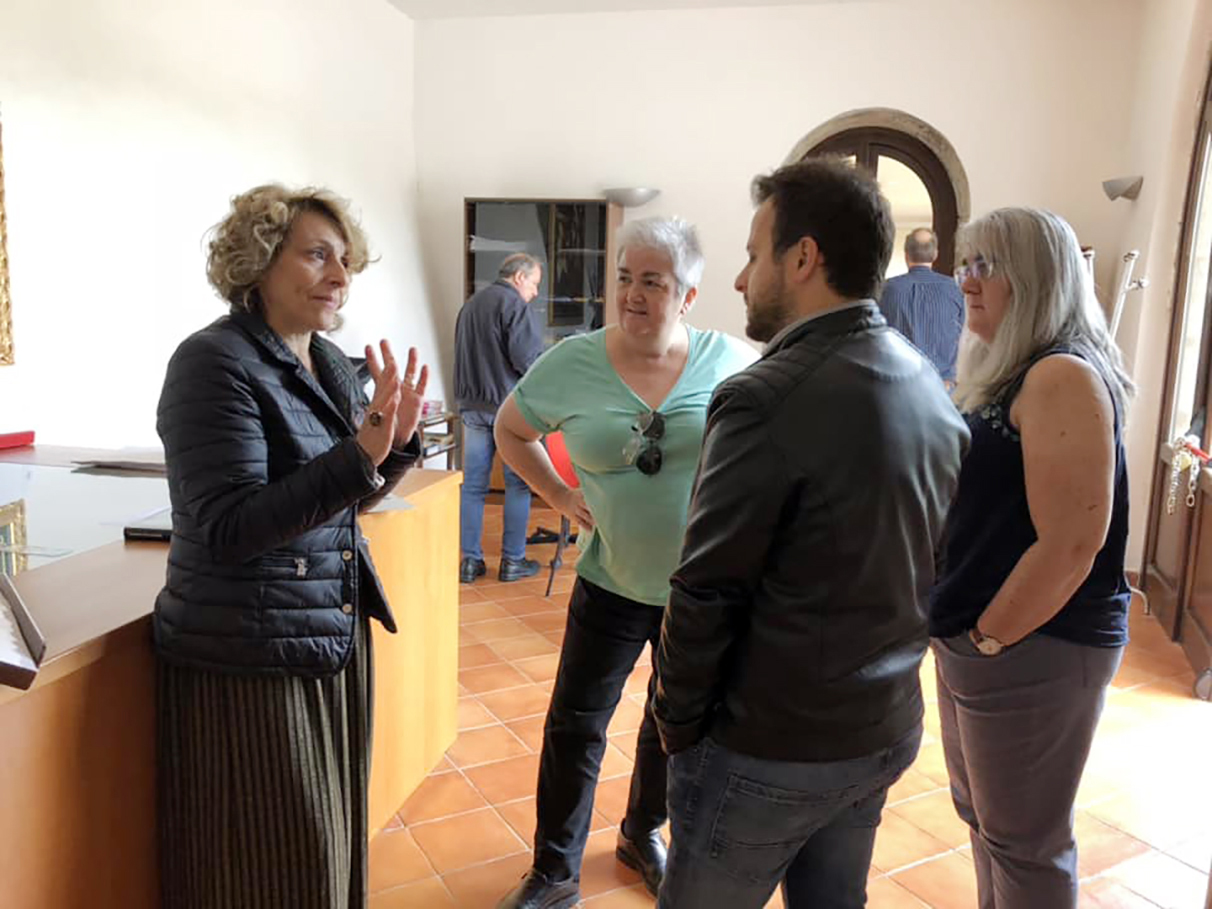
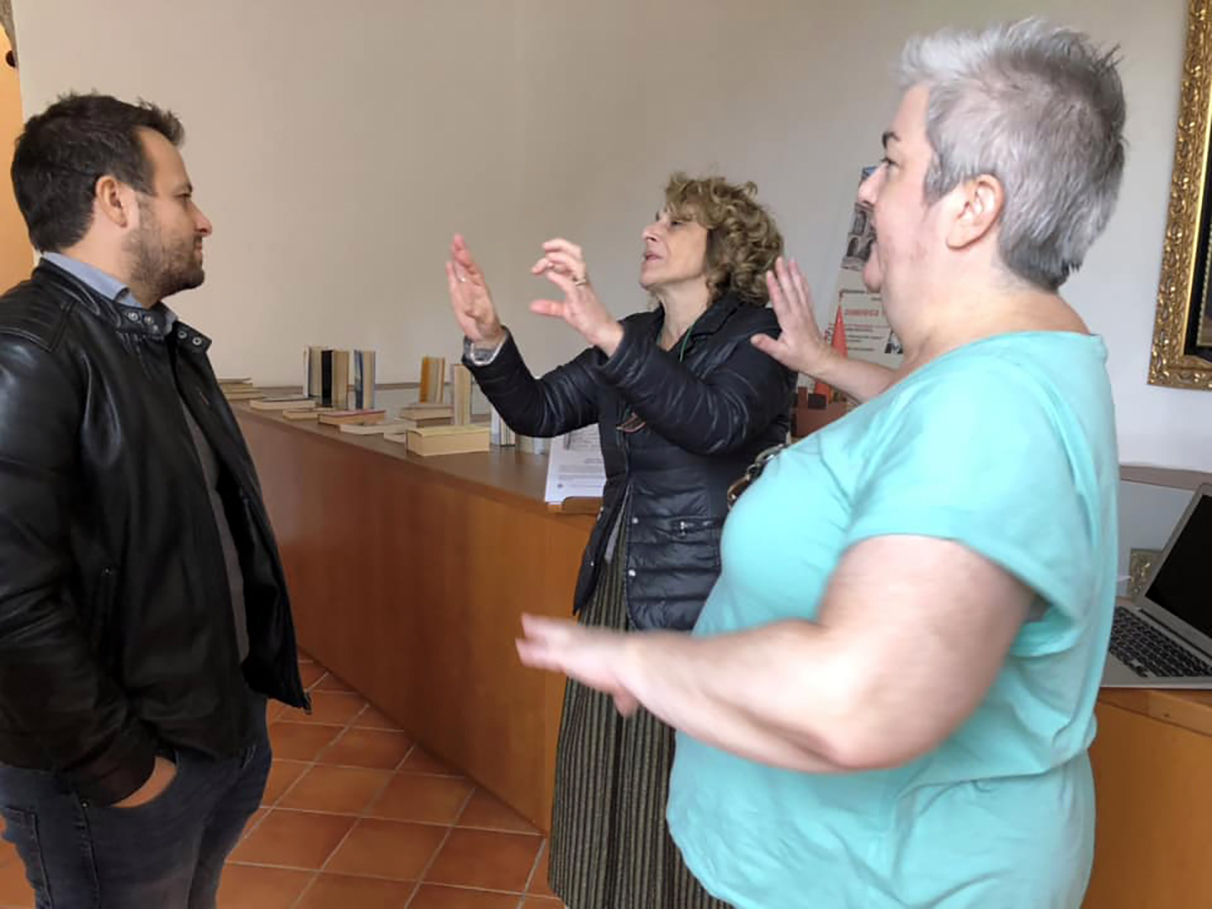
What a head full. I was exhausted trying to keep up with her, and frustrated that she didn’t know anything about the topics I am interested in: Donatus Buongiorno’s career, our family’s tenure in Solofra, etc.
She had to leave at 2 pm. We went back out front. We asked for a recommendation of a restaurant for lunch, and she pointed to La Taverna del Principe across the piazza.
We said goodbye and walked to the restaurant. I invited Giuseppe to join us. What a gold mine. Not only did it give him another two hours to translate for us, but he’s a gourmand who also narrated about the food—of which he approved. He told us that he’s no longer working as a genealogist, actually, but now runs gastronomy tours of the five provinces of Campania—Napoli, Caserta, Avellino, Benevento and Salerno. We let him order for us and choose all the wines.

If you are ready for a gastronomy tour of Italy that your friends who have been to Umbria and Tuscany can only dream about, give this man a call:
Giuseppe G.
Consulente di Viaggi | Aj54
Agenzia di Viaggi /Travel Agency | Aj54, very Authentic Journeys | Via Manfredi, 54 – 83042 Atripalda (Av) | Italy
Tel./Fax. +39 0825 460358 | M. +39 340 3137039
[email protected] | www.aj54.it
After lunch, he walked us to the best dessert place in town—Caffé Vignola—then said goodbye.
The night before, he had sent me some items he photographed at the Avellino library for me. Not until I was back in New York did I look at them and see that they are the 1911 articles about Buongiorno from Le Rane, a vintage local newspaper, which Mimma De Maio, town historian, cites on her site. Yeah!
We sat for coffee and pastries and tried to catch our breath.
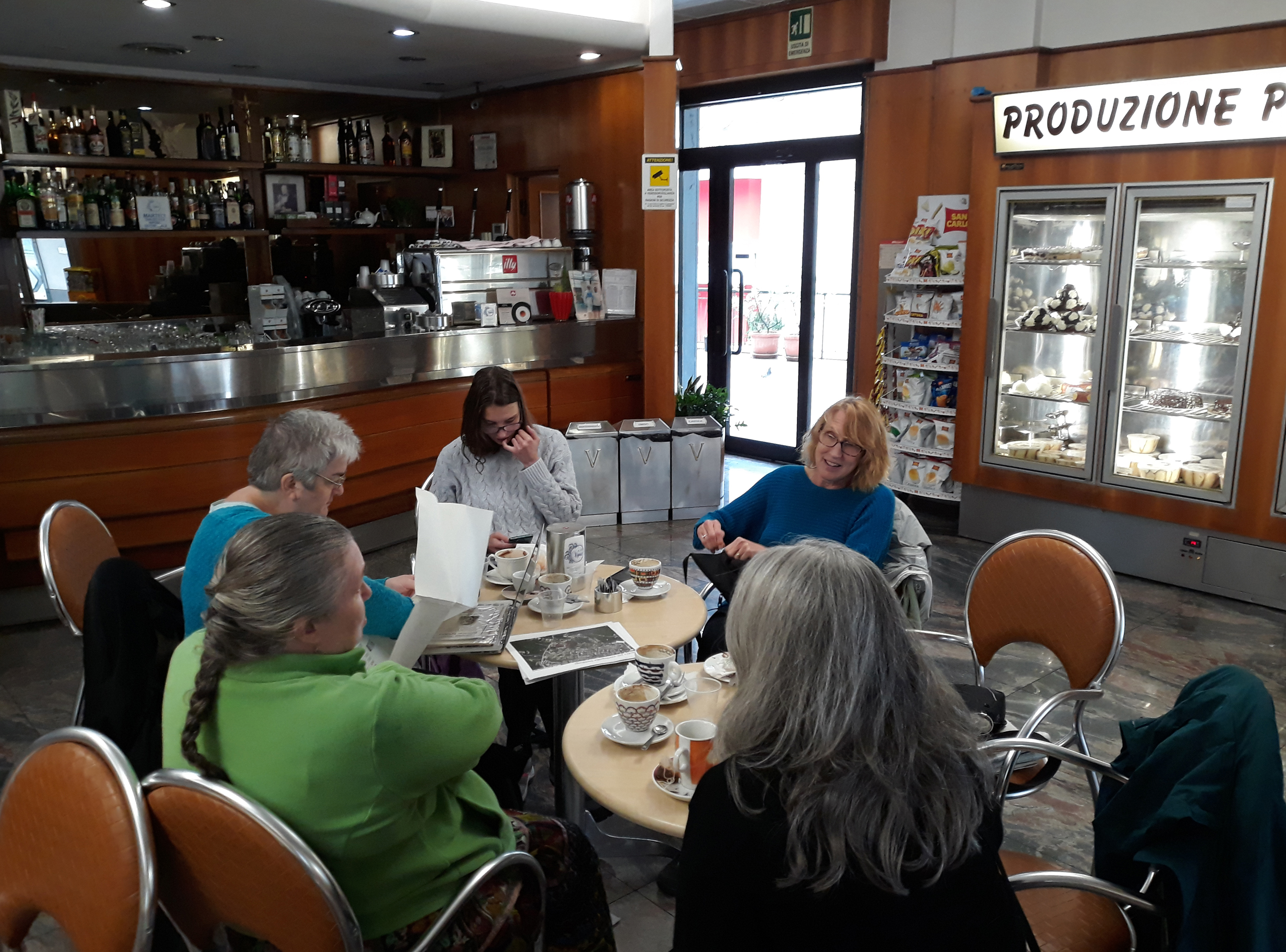
Then we went back to the church to explore at a more leisurely pace. We chatted with “Don Mario” (Monsignor Mario Pierro), the pastor, and met some old men who seem to spend their days hanging around the church. (Curiously, the hang-arounders in New York City Italian Catholic churches are usually elderly women.)
We explained who we were, and, like Lucia, they shrugged at my story of Donatus Buongiorno restoring paintings in the church in 1908, but as soon as they heard “Canonico Troisi,” the flood gates opened. Canon Carmine Troisi, 1866-1948, pastor of the collegiate church for 50 years, was my great-grandfather’s brother. There’s a plaque with the priest’s name on the front of the church, and everyone in town knows who he was.

A few of the men took us into the sacristy to see its paintings (and a glass ossuary holding someone else’s bones including a skull, which was totally gross), and another room where Carmine Troisi’s bones are buried in an ossuary under the floor which has a carved, marble, plaque-like cover. He’s buried with other priests, too, we think—the translating was getting a bit shaky by this point. Then they showed us the farthest-back room, which looked like a school room, which they explained is where Troisi actually died. He had a heart attack or something during catechism class, apparently.
Whew.
So we visited great-grandpa’s brother the priest thoroughly. The priest for whom our great-grandmother, Maria Michela Buongiorno, Donatus Buongiorno’s sister, worked as a housekeeper before marriage, which is how she met great-grandfather Beniamino Troisi. They were married in this church in 1877. Have I adequately explained why we needed to visit this town?
Done with downtown Solofra for the day, we drove up the hill on the north side of town to the Terranova Agriturismo Solofra to check in. Cousins Lisa and Lexie were already there, having come directly from Naples separately from us. Our hosts, Maria Buonanno and her father Norberto Buonanno, are lovely. Later in the evening, Maria cooked us dinner and shot this group photo. (Signor Buonanno is at the table in the back on the left.)
